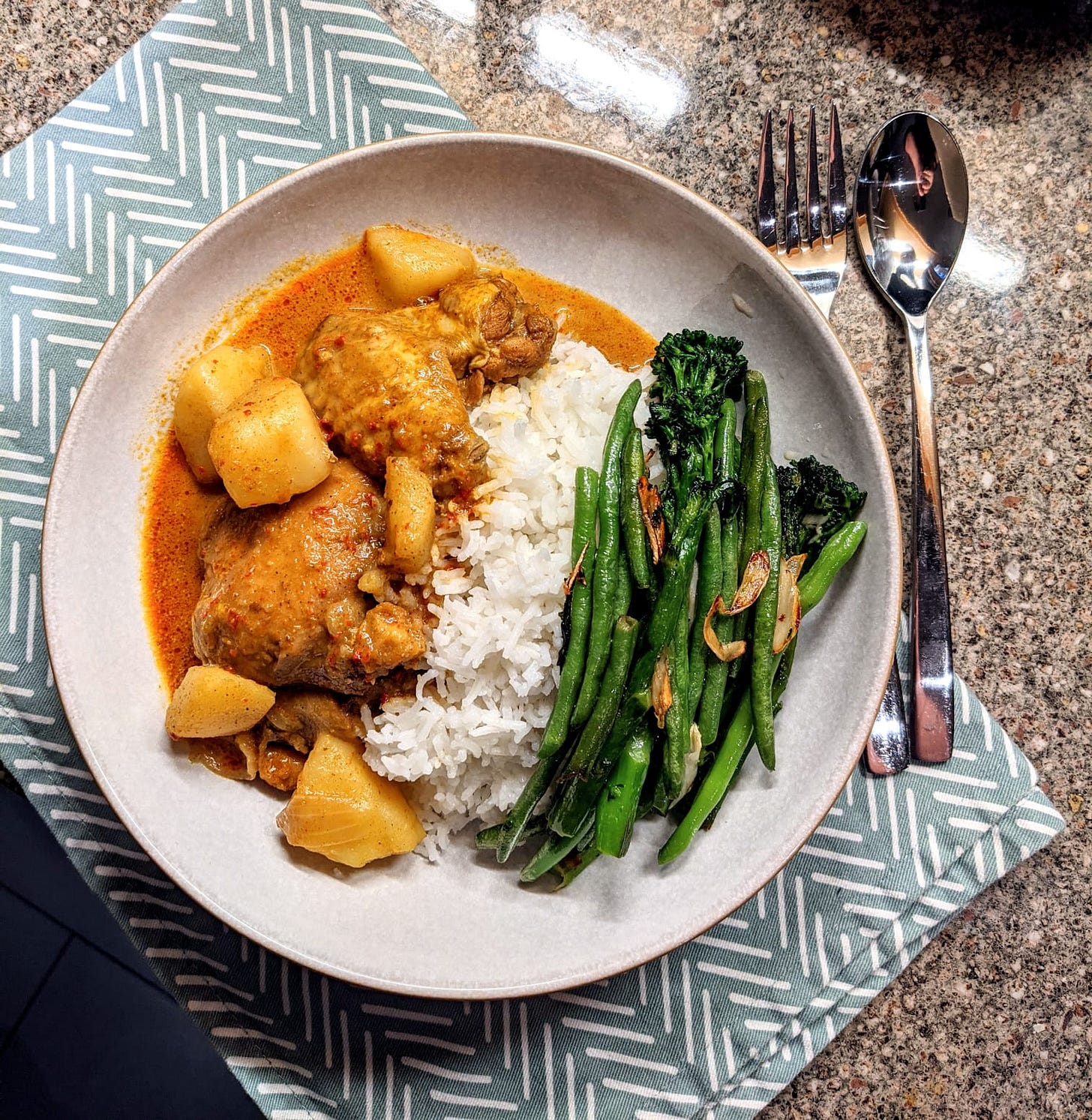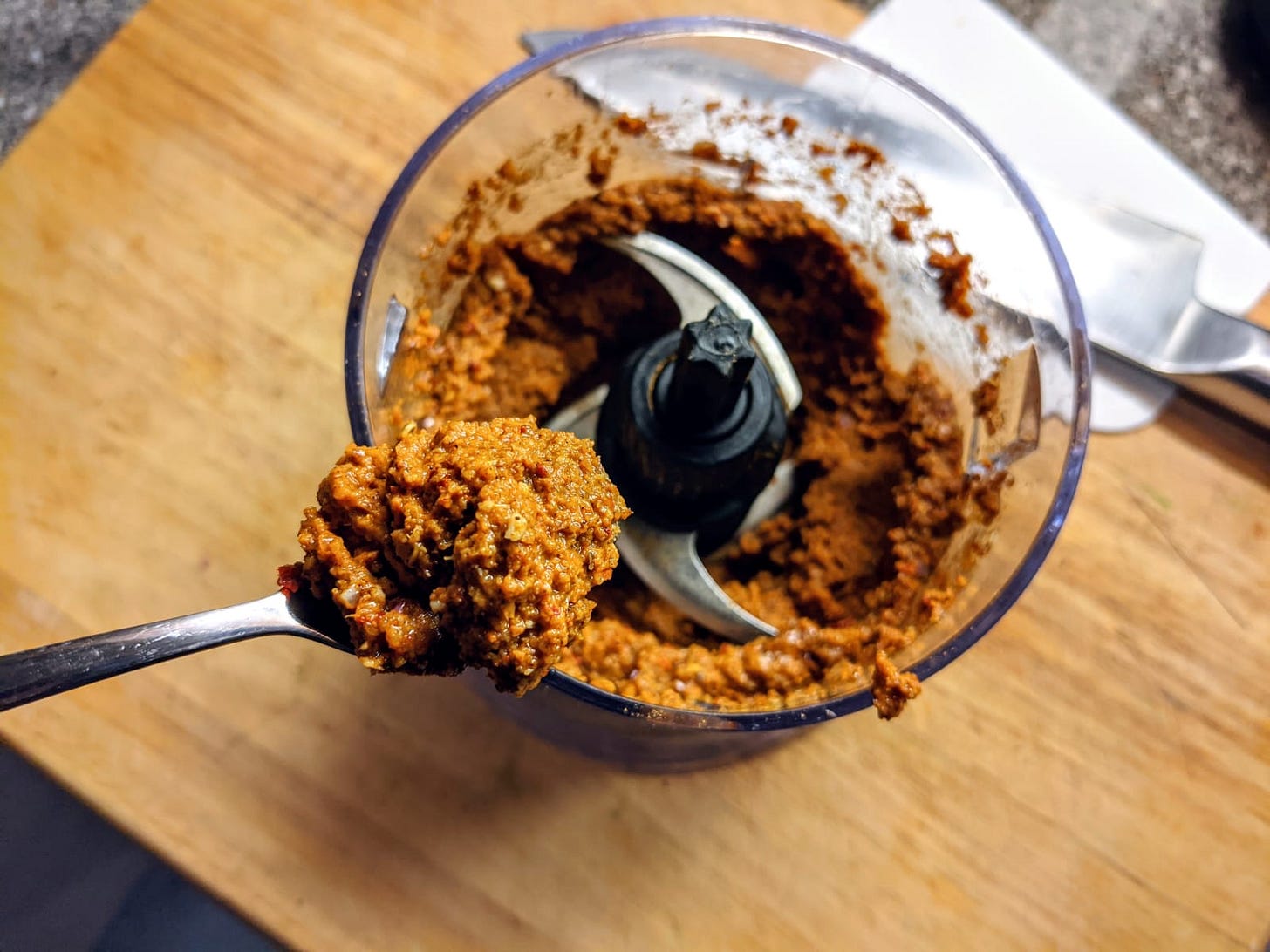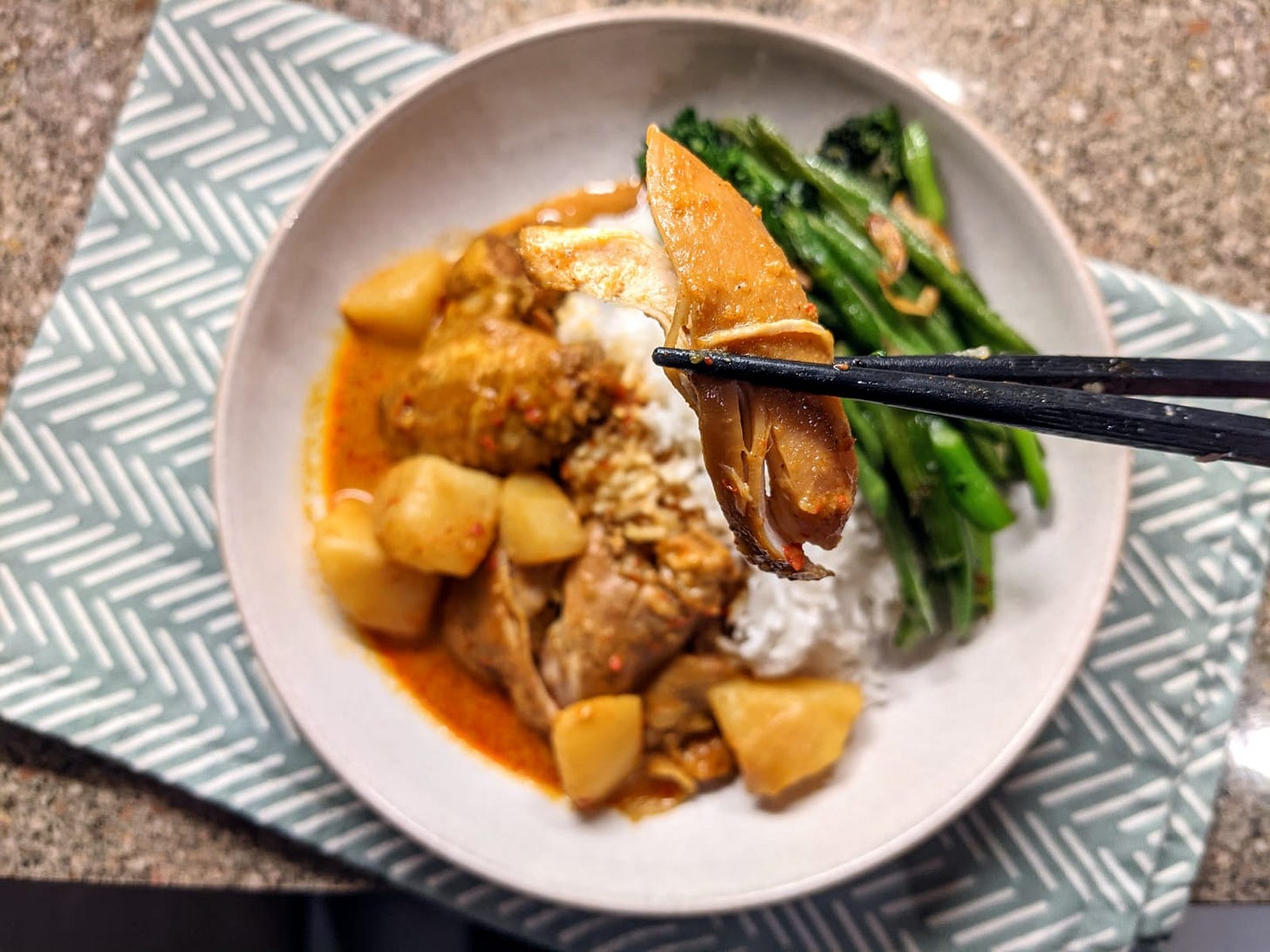Hiya!
ICYMI: National Curry Week was a couple of weeks ago, but instead of Indian curries, all I could think of was one of my favourite chicken curries from back home: the gloriously humble Singapore Chicken Curry.
It is a mild, creamy, yet light and immensely aromatic – and almost brothy – yellow chicken curry which uses soy sauce as its main source of sodium, rather than salt, and is perfect with rice, fluffy white bread rolls, or noodles.
The name itself is a bit of a misnomer, kind of like 'Singapore Noodles', because Singapore – being the melting pot that it is, has grand curry traditions from the Indians, the Malays and the Chinese. This curry is however, largely considered to be a Singaporean-Chinese curry, and can be easily found in cai fan stalls in the hundreds (possibly thousands) of food hawker centres across the country.
It's also worth mentioning that while I call this a Singapore Chicken Curry, you can also find it in neighbouring Malaysia, but let's not get into the never-ending food battle between the two countries as to who invented which recipe, because let's be real, regardless of who takes the credit for it, WE are the real winners, with our clean plates and full, happy bellies (but seriously though, we probs invented it 😉).
My earliest memory of having this chicken curry is in Primary School where one of the lovely aunties in the tuck shop would, at my request, ladle so much of the curry gravy onto my plate that my rice would look like a little iceberg floating along in an ocean of gravy. And since moving to the UK, the only opportunity I'd have to eat this curry was whenever I went back to Singapore, which has been TORTUROUS because I haven't been back in almost two and a half years. One day though, I decided that enough is enough, and after roadtesting a few recipes, I finally found one which made me feel 82.63% less homesick.
Making your own curry paste at home is a truly illuminating experience; you don't fully appreciate the value that each herb and spice brings to the dish until you start frying the curry paste in oil, and every single spice starts perfuming your house with unbelievably intoxicating aromas that transport you straight to the culinary heart of Southeast Asia. And who would've thought that making your own curry paste at home would be so easy as well – most of the work is done in a blender, so there's really no reason not to make this recipe.
Okay Mark - less talking, more cooking please.
Below, I've pulled together elements from this recipe, but as always, have made a few tweaks which I think makes this easier to cook at home (especially in the UK) without needing to go to specialist shops for ingredients, because whilst I love cooking, I am 100% not about to traipse across the city trying to hunt down ingredients which I'll only ever use once.

And speaking of ingredients, this recipe calls for dried chillies to be used as it generally has a greater intensity of flavour and spice. But if you can’t find them easily, don’t fret because you can dry your own chillies at home by laying out fresh chillies on a tray beside a window for a few weeks to naturally air-dry. This is a great way to repurpose unused chillies from the store, minimising food waste.
I've written this in a way which suits how I personally like my recipes laid out – it's got a shopping list up top so you know what you need to buy, and how much of everything you'll need, but the actual measurements of what you'll use for each step are written within the recipe so you can cook on the fly. I'm not someone who pre-weighs and pre-chops everything if I can help it, mostly because it's a bit too fussy, requires washing up extra crockery, and of course because fuss, in general, is NOT my style.
I hope you enjoy this chicken curry as much as I do, and that it gives you a window into some of the flavours that I grew up with and miss dearly.

Shopping list
Serves 4-5
Prep time: 15 mins
Cooking time: 1 hour
Chicken portions, 800 grams, at room temperature (bone-in is preferred, but feel free to go boneless and skinless if you must)
Medium Curry Powder, 5 tablespoons
Light soy sauce, 2.5 tablespoons (plus a couple of tablespoons extra so you can season to taste)
Dried chillies, 6 pieces (or use fresh if you're in a pinch)
Cashew nuts, untoasted, 4 pieces
4 Shallots (or 1 medium red onion)
1 Yellow onion, large
Lemongrass, 1 stick (I get mine from Sainsbury’s so you can defo find this at Asda, Tesco, Waitrose etc.)
Garlic, 4 cloves
Potatoes, 2 large (waxy potatoes are ideal as you still want to maintain some of the texture of the potatoes, but no one's going to complain if you used fluffy, starchy potatoes instead)
A thumb of ginger
Coconut milk, full-fat, 1 tin / 400ml (low-fat coconut milk has absolutely no place in your pantry – give it away, wrap it up as an early Christmas gift for your flatmate – whatever you do, just get rid of it!)
Sugar, 1 teaspoon
Olive oil or vegetable oil
Salt – for the rice, 1 teaspoon (optional)
Basmati rice, 1.5 cups
OR 600g of cooked medium / thick white rice noodles (150g per serving, but don't use udon noodles for this recipe)
OR some fluffy white bread rolls / baguette
Ready, set, cook!
1. Marinade the chicken by adding 1 tablespoon of medium curry powder and 1.5 tablespoons of light soy sauce into the chicken in a bowl. Let this marinate while you proceed with the other steps (you could, of course, prep this ahead of time but I find that's not necessary from a flavour-permeation perspective).
2. Prepare your curry paste in a blender by adding 6 dried chillies (remove the seeds from 4 of them, but remove / keep more depending on your love of spice), 4 cashew nuts, 4 cloves of garlic, 4 shallots, the thumb of peeled ginger, and blend till it's a relatively smooth paste. Add 3.5 tablespoons of medium curry powder and continue whizzing until everything is well incorporated. If it's at any point too dry, add a tablespoon or two of oil to the blender to help it along.

3. Bloom your curry paste by heating up 2 tablespoons of olive or vegetable oil in a pot over medium-high heat, and fry the spice paste until it's pretty dry and the colour deepens to a gorgeous shade of amber. When you start frying the curry paste in the oil, it should initially loosen up, before starting to thicken and clump together again. In total, you'll be frying this curry paste for about 5 minutes.

4. Make the curry by adding 100ml of water to the pot and stirring to emulsify the mixture. Once it bubbles, add the chicken. Rinse the now chicken-less marinade bowl with 100ml of water, and add that to the pot as well. If you're thinking of having this with noodles, add another 100ml of water to loosen it further.
While you're waiting for the curry to come up to a boil again, peel 2 large potatoes and chop them in varying sizes; a few small half-inch cubes, some 1-inch cubes and most of them as large 1.5-inch cubes – the small cubes will cook and crumble to thicken the curry, while the bigger ones will become tender, curry-soaked morsels.
Add the chopped potatoes, 1 roughly chopped yellow onion, 1 stick of lemongrass (bashed three or four times with the back of a knife and sliced in half to release its flavour), along with 1 tablespoon of light soy sauce to ensure that the chicken and potatoes can absorb its umami savouriness while cooking.
Once it boils, cover the pot and turn the heat down to a simmer for 40 minutes, stirring the bottom occasionally.
5. Get your rice ready (skip this step if you already know how to cook rice or are using white rice noodles) by measuring out 1.5 cups of basmati rice into a pot which has a lid that can fit snugly on top. Rinse the rice, using a sieve to drain the water, before returning it back to the pot to rinse again. Removing the extra starch on the rice grains ensures you get fluffy, individual grains of rice when cooked, so be sure to do this a total of three or four times until the water runs pretty clear.
Add the washed rice back into the pot and add twice the amount of water to the volume of rice – so 3 cups of water in total. I like to then add 1 teaspoon of salt before I put it on the hob because it brings out the ricey flavour better (yes, rice has a flavour!) Bring the pot up to a very enthusiastic boil on high heat (you'll know it's enthusiastic enough when it starts threatening to boil over), before turning the heat down to a gentle simmer. Let this bubble gently, uncovered, until the water level dips below the surface of the rice, and big holes start to form.
When you're unable to see anymore more bubbles coming from the big holes in the rice, stretch a sheet of kitchen paper across the top of the pot, and cover it with the lid. After another 3-5 minutes, turn off the heat and leave the pot on the hob for a further 20 minutes to steam.
During this time, don't touch it, don't look at it, don't even THINK about it because the rice needs some 'me time' to finish absorbing the water and dry out. The kitchen paper stretched across the top of the pot absorbs excess moisture and ensures that the water droplets on the lid don't drip back into the rice, making it soggy. AVOID THE SOG AT ALL COSTS.

6. Finish the chicken curry by lifting the lid and adding 1 tin (or 400ml) of coconut milk. (Realistically, you'll only need 300ml of coconut milk but what's one to do with the remaining 100ml? Contemplate its existence? Let it sit unused in your fridge for three months before eventually getting thrown out? I don't think so.) Add 1 teaspoon of sugar to round off the curry and taste. Add more light soy sauce (one teaspoon at a time) if you think it's needed.

And there you go, your very own homecooked, surprisingly easy and relatively quick Singapore Chicken Curry.
I hope you enjoy this taste of nostalgia as much as I do. And don’t forget to drop me an email or leave a comment if you enjoyed it.
See you for another issue of Forks & Chopstix in a couple of weeks!
x Mark
Looking for more recipes to check out, why not these?
Mushroom Shawarma Pitas with Turmeric Yoghurt
Vietnamese Bun Cha with Beef or Tofu
Slow-Roasted Gochujang Chicken with the works
Or follow me on Instagram for more: @forksandchopstix


